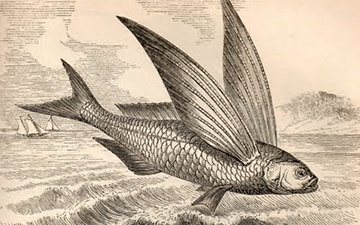Exocoetidae is a family of marine fish in the order Beloniformes of class Actinopterygii. Fish of this family are known as flying fish. There are about sixty-four species grouped in seven to nine genera. Flying fish can make powerful, self-propelled leaps out of water into air, where their long, wing-like fins enable gliding flight for considerable distances above the water’s surface. This uncommon ability is a natural defense mechanism to evade predators.
The oldest known fossil of a flying or gliding fish, Potanichthys xingyiensis, dates back to the Middle Triassic, 235–242 million years ago. However, this fossil is not related to modern flying fish, which evolved independently about 65 million years ago.[1][2]
Flying fish live in all of the oceans, particularly in tropical and warm subtropical waters. Their most striking feature is their pectoral fins,[5] which are unusually large, and enable the fish to hide and escape from predators[6] by leaping out of the water and flying through air a few feet above the water’s surface. Their flights are typically around 50 meters (160 ft).[7]
To glide upward out of the water, a flying fish moves its tail up to 70 times per second.[8] It then spreads its pectoral fins and tilts them slightly upward to provide lift.[5] At the end of a glide, it folds its pectoral fins to reenter the sea, or drops its tail into the water to push against the water to lift itself for another glide, possibly changing direction.[5][8] The curved profile of the “wing” is comparable to the aerodynamic shape of a bird wing.[9] The fish is able to increase its time in the air by flying straight into or at an angle to the direction of updrafts created by a combination of air and ocean currents.[5][8]
Genus Exocoetus has one pair of fins and a streamlined body to optimize for speed, while Cypselurus has a flattened body and two pairs of fins, which maximizes its time in the air. From 1900 to the 1930s, flying fish were studied as possible models used to develop airplanes.[8]
Exocoetidae feed mainly on plankton. Predators include dolphins, tuna, marlin, birds, squids and porpoises.[8]
(From Wikipedia, October 2013)



